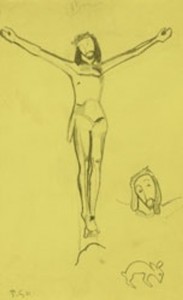January, 2010
Tuesday, January 19th, 2010
| Apart from the highly successful manufacture of U-Boats during both world wars, due, in part – particularly during WWII -, to their financially advantageous use of slave labour, the Thyssens have not always been fortunate in their shipbuilding endeavours; as you will see from our book ‘The Thyssen Art Macabre’, which exclusively reveals the full details of Heini Thyssen’s legendary ‘Swiss’ banana boat company.
But more recent embarrassments have included the Greeks’ reluctance to pay for several submarines built by ThyssenKrupp Marine Systems which they considered unfit for purpose. Somewhat more ironic is the news that the Israelis, of all people, have agreed to commission ThyssenKrupp to build them two frigates, possibly with the additional incentive of various financial aid measures supplied by the German government.
Even less successful has been the manufacture of commercial ships which has been reflected by the news that the ThyssenKrupp owned shipyard Blohm + Voss is in future intending to abandon all commercial shipbuilding. Unfortunately, the story doesn’t end there.
Due in part to the inclement financial situation and ThyssenKrupp’s disastrous investment in Brazil, they have decided to sell off a number of divisions in a grand spring sale. First through the door, by all accounts, were the guys from Abu Dhabi MAR. Not content with assisting in bailing out the world’s largest and most spectacular property fiasco in neighbouring Dubai, Abu Dhabi has expressed an interest in buying into ALL ThyssenKrupp’s shipbuilding enterprises, both commercial AND military.
No one has seen fit to comment on how this might affect the Israelis’ frigates, but the concept of German-funded, Muslim-built, Jewish warships is certainly an interesting one. Perhaps the companies involved could ask the court in Augsburg if it could lend them Karl-Heinz Schreiber for a while to help seal the deals.
* * * * * * * * * * * * * * * * * * * * * * * * * * * * * * * * * * * * * * * * * * * * * *
Abgesehen vom überaus erfolgreichen U-Boot-Bau in beiden Weltkriegen, teils basierend – vor allem im 2. WK – auf ihrer finanziell vorteilhaften Anwendung von Zwangsarbeit, waren die Schiffsbauunternehmungen der Thyssens nicht immer erfolgreich; dies ist in unserem Buch ‘Die Thyssen-Dynastie. Die Wahrheit hinter dem Mythos’ nachzulesen, welches alle Details über Heini Thyssen’s ruhmreiche ‘Schweizerische Bananendampfer-Firmen‘ exklusiv darlegt.
Peinlichkeiten jüngeren Datums schliessen Griechenlands Verweigerung der Zahlung für eine Anzahl von U-Booten ein, die von ThyssenKrupp Marine Systems gebaut wurden, und bei denen der Auftraggeber technische Mängel anprangerte. Etwas ironischer ist die Neuigkeit, dass ausgerechnet die Israelis beschlossen haben, bei ThyssenKrupp den Bau zweier Fregatten in Auftrag zu geben, und zwar möglicherweise unter Zuhilfenahme verschiedener finanzieller Unterstützungsmassnahmen der deutschen Regierung.
Noch weniger erfolgreich war seit einiger Zeit die Produktion von Handelsschiffen, was daran ablesbar ist, dass die zu ThyssenKrupp gehörende Blohm + Voss Werft in Zukunft jeglichen Handelsschiffsbau abstossen will. Leider ist die Geschichte damit noch nicht zu ende.
Unter anderem aufgrund der schlechten Finanzlage und ThyssenKrupp’s katastrophalen Fehlentscheidungen in Brasilien hat man beschlossen, eine Anzahl von Zweigen in einem grossangelegten Frühjahrsschlussverkauf zu veräussern. Als erste Anwärter präsentierten sich die Leute von Abu Dhabi MAR. Ungesättigt von seinen Rettungsaktionen nach dem erstaunlichen Immobilienfiasko des Nachbarstaats Dubai hat Abu Dhabi nunmehr sein Interesse daran angekündigt, sich in ALLE Schiffsbauunternehmungen von ThyssenKrupp einzukaufen, sowohl im zivilen wie auch im militärischen Bereich.
Bisher hat noch niemand kommentiert, wie sich dies auf die Israelischen Fregatten auswirken könnte, aber das Konzept von jüdischen Kriegsschiffen, welche von Deutschland finanziert und von Muslimen gebaut werden ist sicherlich hochinteressant. Vielleicht können die beteiligten Firmen ja beim Gericht in Augsburg anfragen, ob sie sich Karl-Heinz Schreiber eine Zeit lang ausleihen können, bis die Geschäfte erfolgreich abgeschlossen sind. |
 HH Sheikh Khalifa bin Zayed bin Al Nahyan, current President of the United Arab Emirates (UEA) and emir of Abu Dhabi  Civilian or military? That's the 100 Billion Dollar question  Schreiber The Fat Man, Singing |
Tags: Abu Dhabi MAR, Augsburg, Blohm + Voss, Brasilien, Brazil, Die Thyssen-Dynastie, Die Wahrheit hinter dem Mythos, Fregatten, frigates, Heini Thyssen, Karl-Heinz Schreiber, Schiffsbau, shipbuilding, slave labour, The Thyssen Art Macabre, ThyssenKrupp, ThyssenKrupp Marine Systems, U-boats, U-Boot, Zwangsarbeit
Posted in The Thyssen Art Macabre, Thyssen Corporate Comments Off on ThyssenKrupp’s Spring Sale Complications
Tuesday, January 19th, 2010
| There is nothing new about plagiarism, and I must admit to being rather proud when I realised how much of my book on the Thyssens Elfriede Jelinek had used in her play ‘Rechnitz (The Exterminating Angel)’, crediting it in the published version of her play. But I also appreciated the irony in the fact that she had acknowledged her use of T. S. Eliot’s ‘The Hollow Men’, for Eliot was a master of literary borrowing.
However, when Jelinek subsequently accused me in Professor Walter Manoschek’s Book ‘Der Fall Rechnitz’ of basing ‘The Thyssen Art Macabre’ on ‘hearsay’, I thought a little light-hearted revenge might be in order, now that I have discovered the secret of her writing style:
First you need to write a play. Any play. Then you feed it through a computer translator into any other language. Then reverse the process back into the original language – and heyho! and voila! – you have instant Jelinek. Try it!
**************************************************************************************
Literarischer Diebstahl ist nichts neues und ich muss gestehen, dass ich ziemlich stolz war, als mir klar wurde, wieviel von meinem Buch über die Thyssens Elfriede Jelinek in ihrem Stück ‘Rechnitz (Der Würgeengel)’ verwendet hatte; sie erwähnt es in den Danksagungen der gedruckten Version. Ich war mir allerdings auch bewusst, wie ironisch die Bestätigung ihrer Verwendung von T. S. Eliot’s ‘The Hollow Men’ ist, denn Eliot war ein grosser Meister des Plagiats.
Als Jelinek mir jedoch im Nachhinein in Professor Walter Manoschek’s Buch ‘Der Fall Rechnitz’ vorwarf, mein Buch (deutsche Ausgabe: ‘Die Thyssen-Dynastie. Die Wahrheit hinter dem Mythos’) sei ein ‘meist auf Hörensagen beruhendes Buch’, dachte ich mir, es wäre nunmehr an der Zeit für ein bisschen scherzhafte Rache, zumal ich das Geheimnis ihres Schreibstils entdeckt hatte:
Zunächst müssen Sie ein Stück schreiben. Irgendein Stück. Dann schicken Sie es durch das Uebersetzungsprogramm auf Ihrem Computer in irgendeine andere Sprache. Danach schicken Sie es wieder zurück in die Originalsprache – und presto! und sodele! – schon haben Sie Instant-Jelinek. Probieren Sie’s mal! |
 Time can be so cruel  'Plagiarise, Plagiarise, Let no one else's work evade your eyes' (Tom Lehrer) |
Tags: Computer translation programme, Der Fall Rechnitz, Der Würgeengel, Die Thyssen-Dynastie, Die Wahrheit hinter dem Mythos, Elfriede Jelinek, Literarischer Diebstahl, Plagiarism, Plagiat, Rechnitz, T. S. Eliot, The Exterminating Angel, The Hollow Men, The Thyssen Art Macabre, Uebersetzungsprogramm, Walter Manoschek
Posted in The Thyssen Art Macabre, Thyssen Family Comments Off on Nobel Prize Winning Austrian Playwright Elfriede Jelinek’s Thyssen Book Hearsay Accusation Sparks British Author David R. L. Litchfield’s Literary Revenge Attack And Style Exposure
Sunday, January 10th, 2010
| At last! Spain begins to question the quality of the Thyssen-Bornemisza Collection, what the taxpayers might have got for their money and the wisdom of paying yet more money for ‘Tita’s Collection’. These were all things we have been publicly questioning for the last three years. So why has it taken so long? Without wishing to sound cynical, could it be a result of the credit crunch? While Spain was flooded with Euros, nobody wanted to see the King naked.
Today’s critic, Dr Juan Jose Junquera, is a Professor of Art History at Complutense University in Madrid, and as such could hardly claim to be a stranger to the collection. Perhaps the Thyssen-Bornemisza Collection Foundation Board, particularly Sir Norman Rosenthal, will now be obliged to make a comment, though with Rosenthal’s wife still working at the Prado, he could of course be accused of a conflict of interest.
The following is a translation of the Spanish original from today’s ABC newspaper.
No wonder Tita is busy preparing Villa Favorita in Lugano for re-occupancy. This feature looks to me like the Culture Ministry’s way of say ‘No’ to any further deals with Tita and if this one hits the buffers, Malaga looks ever less likely.
“After reading Carmen Cervera’s declarations in ABC on Sunday 3 January, I’ve had the following thoughts: I’m not doubting the generosity of her offer to loan the Thyssen Collection, but I’m asking myself of how much interest it actually is to the Spanish taxpayers. We still don’t know which paintings will stay in Spain once the current cession agreement concerning the collection of her late husband, Baron Thyssen-Bornemisza, ends, which was a question raised in its day by the then Director of the Prado, Professor Perez Sanchez, and to which there still hasn’t been a reply. In the meantime, the Prado lacks good quality Dutch paintings, such as Franz Hals, gaps which the Dutch Masters of the Thyssen Collection cannot fill. Is it really advisable to spend the few Euros that the Culture Minisry has available in order to rent a Gauguin escorted by paintings of somewhat dubious quality and authenticity on a background of nineteenth century artists whose works already gather dust in the storage rooms of both the Prado and provincial museums? Nobody doubts the commercial acumen of Baroness Thyssen; but what we mustn’t do is buy a lift for a bungalow without discussing the matter in public.”
http://www.abc.es/20100110/opinion-cartas/lectores-20100110.html
ABC Y SUS LECTORES, Domingo , 10-01-10
……..«La atenta lectura de las declaraciones de doña Carmen Cervera en ABC del domingo 3 de enero me sugiere unas reflexiones -dice JUAN JOSÉ JUNQUERA, catedrático de Historia del Arte de la Universidad Complutense-. No es que dude de la generosidad de su oferta de alquiler de la colección Thyssen, pero me pregunto hasta qué punto éste interesa a los contibuyentes españoles. Aún no sabemos cuáles son los cuadros que quedarán en España cuando acabe el convenio vigente de cesión de la colección de su difunto marido, el barón Thyssen-Bornemisza, pregunta que formuló en su día el que era director del Prado, profesor Pérez Sánchez y que aún no tiene respuesta. Mientras, el Prado carece de holandeses de calidad como Franz Hals, huecos que no cubren los maestros holandeses de la Colección Thyssen. ¿Realmente interesa gastar los poco euros de que dispone Cultura en alquilar un Gauguin escoltado por cuadros bien de dudosa calidad o autenticidad, bien de segundones decimonónicos cuyas obras decansan en los depósitos del Prado y de los museos de provincias? Nadie duda de las cualidades comerciales de la baronesa viuda Thyssen; lo que no debemos hacer es, sin discutirlo públicamente, comprar un ascensor para un chalet de planta baja……..». |
 One of Tita's ten 'Gauguins (?)', which could become the subject of her forthcoming 'cleansing' operation (see ABC newspaper on 03.01.2010).  "'The Crucifixion', attributed to a painter from the circle of Sir Anthony van Dyck, which Heini purchased from Sotheby's at the 1995 sale of the Bentinck-Thyssen Collection for only £17,000 and immediately re-attributed to the Master himself" (from: 'The Thyssen Art Macabre' / 'La Historia Secreta de los Thyssen') |
Tags: ABC newspaper, Anthony van Dyck, Bentinck-Thyssen Collection, Carmen Cervera, Credit Crunch, Culture Ministry, Franz Hals, Gauguin, Juan Jose Junquera, Lugano, Malaga, Perez Sanchez, Prado, Sir Norman Rosenthal, Sotheby's, Spain, Taxpayer, Thyssen-Bornemisza Collection, Thyssen-Bornemisza Collection Foundation Board, Universidad Complutense, Villa Favorita
Posted in The Thyssen Art Macabre, Thyssen Art Comments Off on Thyssen Art Elevator Hits Spanish Buffers
|








